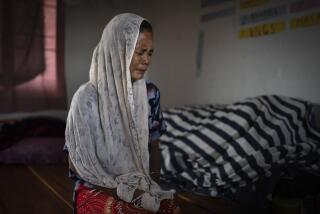118 Ethnic Refugees in Borneo Massacred After Police Flee
- Share via
SAMPIT, Indonesia — Borneo headhunters waging a war of “ethnic cleansing” massacred 118 refugees as police were escorting the terrified villagers to what they thought was safety, police officials and community leaders said Tuesday.
Six officers assigned to protect the ethnic Madurese refugees fled when dozens of Dayak warriors, wielding spears and long knives, attacked the group near the village of Parangian. The victims included pregnant women, children and old men.
The blood bath is the single biggest slaughter recorded in 10 days of ethnic clashes between the indigenous Dayaks and immigrant settlers from the island of Madura. The attack occurred Sunday but didn’t become public until Tuesday.
“The problem is, the Dayaks are very angry. They are uncontrollable,” said Bahang Djimat, secretary of the Dayak Community Organization of Central Kalimantan. “They don’t recognize whether they are women or children. They just see them as animals that have to be destroyed.”
For decades, the Dayaks have resented the Madurese settlers for ignoring Dayak tradition and dominating commerce in Kalimantan, the Indonesian part of Borneo. They have come to see the Madurese as an evil that must be eradicated.
After a violent clash between members of the two groups Feb. 18, the Dayaks went on a rampage of killing and decapitation with the aim of driving the Madurese from the province.
They have already accomplished much of their goal, with whole towns and villages emptied of their Madurese residents.
More than 60,000 Madurese have fled their homes, leaving the island on rescue ships, staying in squalid refugee camps or hiding in the jungle to escape roaming bands of headhunters.
To make the return of the Madurese more difficult, the Dayaks have burned hundreds, if not thousands, of their homes.
The Dayaks report that they have killed 2,000 Madurese, in many cases cutting off their heads as trophies, drinking their blood and cutting out their hearts and eating them on the spot.
The Indonesian government reports that 428 people have died since the unrest began, but that tally doesn’t include hundreds of headless corpses that couldn’t be identified. Nor does it include countless bodies that have been left in the jungle to rot or have floated downriver and out to sea.
Some Dayaks have said the refugees should be given safe passage to ships so the province can be rid of Madurese quickly. The police have been organizing the rescue of refugees from the jungle and taking them in trucks to refugee centers.
The Madurese killed near Parangian were among 2,000 residents who fled into the jungle last week when the village was attacked by Dayaks.
After police promised to take the refugees to safety, hundreds emerged from hiding Sunday. As they waited for transportation to a refugee camp, a group of armed Dayaks appeared.
The Dayaks killed a woman and her child, witnesses told the Associated Press, and kicked the woman’s head down the street. They then forced 118 Madurese into trucks, took them to a nearby soccer field and butchered them.
“As they got down from the trucks they were killed right away,” Marjo, a villager who witnessed the killings, told AP. “Chop chop! There was no way they could run. They fell suddenly as they were chopped.”
Residents carried the bodies to a mass grave Monday.
Bahang, the community leader, defended the slaughter, saying the Dayaks believed that the villagers were trying to kill them.
“The Dayaks thought it was an attack,” he said. “[The refugees] were running to the village.”
After letting the Borneo blood bath go on for more than a week, the Indonesian police and military began exerting more control over the region Tuesday--at least during the daytime. Troops took over a checkpoint that had been controlled by Dayak warriors and began confiscating weapons from the fighters.
But at the port in Sampit, where the Madurese refugees were being loaded onto ships, police and army troops fired at each other Tuesday, killing one refugee and injuring at least 10 soldiers and police officers.
The cause of the dispute was unclear, but some speculated that the two units clashed over how to divide money demanded from refugees before they could board the ships.
On Monday night, a joint police and military force in Sampit raided the Hotel Rama, which had served as a command center for the headhunters.
Police arrested about 75 Dayak warriors at the riverfront hotel and seized hundreds of spears, blowguns and machete-like knives called mandau. The fighters were stripped to their underwear and carted off in two trucks, said neighbors who watched the action.
Not far from the hotel, troops killed two Dayaks and arrested 25 more Monday and Tuesday.
Behind the building Tuesday, five severed heads floated in the river near the hotel dock. Two were still in a white bag used by the headhunters to transport the heads.
Bahang said the Dayaks had hidden about 100 heads under the building so the police wouldn’t find them.
The warriors had brought the heads to the hotel in recent days as part of a plan to distribute them as war trophies among the various Dayak villages, he said. At least one of the bags, however, apparently fell from its hiding place into the water and began disgorging its gruesome contents.
With the smell of decomposing flesh growing more unpleasant, a neighbor used a long pole to push the heads out into the current and let the river take them.
More to Read
Sign up for Essential California
The most important California stories and recommendations in your inbox every morning.
You may occasionally receive promotional content from the Los Angeles Times.












